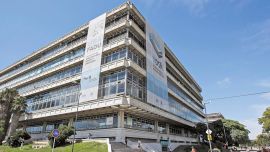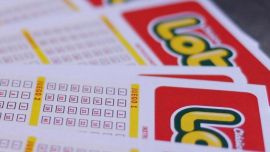Out of the 47 exhibitions put on by the country’s most important museum, the National Museum of Fine Arts (MNBA), over the last five years, only two starred women artists. The Grand Prize in Painting of the National Salon has honoured 92 men since 1911, as opposed to just five women. To use a more contemporary context, at last year’s arteBA art fair, the galleries in the principal section displayed 107 female artists, out of a total of 332 on display. This percentage equates roughly with the three women sent by Argentina to the Venice Biennale, out of a total of 10 artists over the last 17 years.
The imbalance is clear and women in the arts are calling for change.
They are demanding more equal representation and visibility in the nation’s museums, galleries and cultural centres, while a new movement of female voices from the art world are urging establishments across the country to shine a light on female artists. And not just on International Women’s Day, this March 8, but beyond and into the future.
NEW CLIMATE
Ever since women last year decided to speak out against sexual harassment, through the use of the #MeToo hashtag on social media, a new climate has emerged, with women not only condemning sexual abuse and harassment, but also male domination in power relations, and gender inequality in society at large.
In Argentina, the Ni Una Menos movement preceded this new wave, arising as a response to the large amount of femicides happening in the country. Ni Una Menos has been able to gather hundreds of thousands of women together, each of them crying out against machismo, gender violence and femicide (the killing of a girl or woman directly related to their gender, most in domestic situations), a crime which happens around once every 30 hours. Journalists, activists and artists have joined together and decided to use their power to make the issue more visible. And it is working: the whole world has taken note.
But the problems have not evaporated. Machismo is deeply rooted within culture, which is why feminist artists have decided to come together, to try and change our visual culture and the representation of women within the world of art.
Nosotras Proponemos (NP) is made up of a group of women in the arts. It originated after the death of the socially engaged artist, Graciela Sacco, at the end of last year. Her passing inspired another artist, Leticia Obeid, to write 10 proposals on her Facebook wall that would change the social conditions facing female artists. Others, such as Andrea Giunta, one of the curators of the appraised “Radical Women: Latin American Art 1960-1985,” a show based upon extensive research of art made by women in Latin America, until then not necessarily considered part of the art historical canon, shared Obeid’s post. And within no time at all, Obeid’s 10-point plan had evolved into a 37-point manifesto.
The manifesto proposes equal representation within the art world, in exhibitions, collections and in leadership positions. They urge a change in behaviour; against intimidation, patriarchal strategies and lower pay for women. Within a few weeks, the manifesto had been signed by over 3,000 people.
EQUAL REPRESENTATION
Among the signatories was Andres Duprat, the director of the National Museum of Fine Arts. As a man in charge of this particular museum, one not exactly considered exemplary for the balance of genders in its collection, it was a bold move.
“I was fully aware of the importance of me signing the manifesto and I did so with complete conviction,” he told the Times in an interview. “The National Museum of Fine Arts commits to readjusting imbalances in history. I am aware that it is a complex and delicate task and we would not want to simplify it or like to be seen as opportunistic, yet we need to be sensible and work to change disparities, such as a more equal representation of women.”
After having been approached by a delegation from NP’s Assembly of Feminist Workers in the Arts – comprised of a diverse group of women from different generations and positions in the art world – the museum has indicated that it is now researching the proportion of women in its national collection. How imbalanced is the make-up? This investigation is still ongoing. No-one has ever looked into it before.
However, some beautiful works by women from the MNBA’s collection have been brought together and, as of March 1, they were put on display in A la conquista de la luna, a collection with works by Diana Dowek, Elba Bairon, Graciela Sacco, Liliana Porter, Mónica Millán, Noemí Gerstein and Raquel Forner. On the façade images of Liliana Maresca and Juana Romani have arisen.
The museum also agreed to follow up on an initiative suggested by Nosotras Proponemos, a decision that subsequently sparked unique repercussions throughout the entire country. In the weeks prior to and after International Women’s Day on March 8, from the 2nd of the month to the 18th, between 6pm and 6.30pm, museum spotlights will only shine on works of art made by women. Leaving most of the museum in the dark, this performative act of illuminating unequal representation in collections and exhibitions is a powerful message detailing just how much unseen art produced by female artists. there is, which, at least in contemporary art, makes up more than 50 percent.
The MALBA (Latin American Art Museum of Buenos Aires) has been aware of existing gender inequality in the arts and has taken steps to close the gap in the last four years, under the direction of Agustín Pérez Rubio. One example has been a continuously changing exhibition of art by Latin American women, featuring those have not received the merit they should have had in their lifetime. Mirtha Dermisache, Claudia Andujar, Teresa Burga and Anne Marie Heinrich are amongst the pearls that have been presented within this framework.
On March 8, in collaboration with NP, the museum will display a list of over 900 names of women artists on their façade, illustrating, just by their names, that they exist. The NP manifesto will also be handed out to the public and on March 9, at 7pma special feminist performance will be held on the museum’s doorsteps.
The façade of Salta’s contemporary art museum will also display NPs statement with its stated aims and goals, alongside names of local female artists underrepresented in the arts, echoing the move. And in Neuquén spotlights will be shining on the women’s artworks, pamphlets will be handed out, and a film cycle organised on women’s rights runs throughout the month of March. The provincial museum of Tucuman will also illuminate the scarcity of women art in their own exhibitions, from March 1 to 11. In Paraná, Entre Ríos only one light suffices, to show the work by Emilia Bertolé, the only female represented in the permanent exhibition of the Provincial Museum of Fine Arts Dr. Pedro E. Martínez.
In all, more than 30 institutions, from Patagonia to the northern Andes, are responding to the call of Nosotras Proponemos to illuminate and shine a light on art made by women, illustrating current inequality – and a promise for improvement in the future.


























Comments